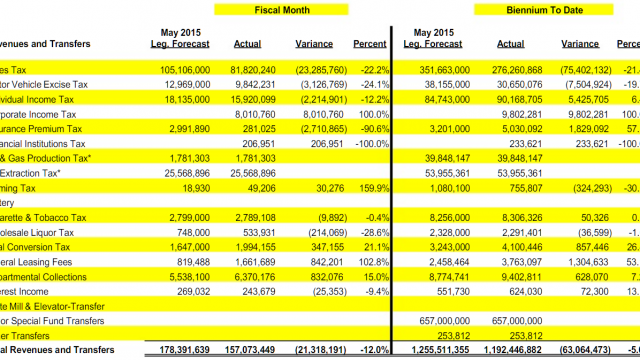North Dakota Tax Revenues Continue To Come In Under Forecast

When the August general fund revenue numbers were released by the Office of Management and Budget last month one lawmaker described them to me with one word: “Ugly.”
By that measure the September numbers (see below) are even uglier, because they show the state falling further behind revenue forecasts. Last month’s report showed the state’s revenues were coming in 3.9 percent under the forecast, but this month that lag is up to 5 percent.
The biennium-over-biennium numbers are still strong – through September the state has collected 15.4 percent more overall than at the same point in the last biennium – but that gap is shrinking (the state was up 34.5 percent last month) and lawmakers don’t budget based on last biennium’s revenues. They budget based on their forecast for the coming biennium’s revenues.
So every percentage point actual revenues fall behind forecast is a problem. Here’s a comparison the actual revenues collected versus forecast for the current biennium to date:
To provide some context, though, here’s the actual revenues for the first three months of the current biennium compared to the last four bienniums. The state is still collecting one hell of a lot more money than it was even just a couple of years ago.
The question is, how far will revenues fall and how fast?
The sales tax, in particular, is a trouble spot. “It’s really a double whammy on North Dakota’s budget with low Ag and Oil prices,” Rep. Roscoe Streyle (R-Minot), a member of the Budget Section committee, told me when last month’s revenue report was released. “A large portion of the sales tax increase over the past 5 years is directly related to drilling and the oil industry. The sales tax revenue needs to be watched very closely in the coming months. North Dakota’s economy is still strong, but it’s clear low commodity prices are impacting the state in a big way.”
So far, the sales tax numbers might be the ugliest line item in the OMB report. Through September sales tax collections are coming in 21.4 percent under forecast, missing by more than $75 million, and 15.3 percent (nearly $50 million) under the previous biennium.
There’s just a lot less commerce going on in the state right now, and that means less revenue.
Individual income tax collections are way down too – falling over 21 percent from last biennium – which isn’t at all hard to believe given that collections of unemployment benefits have more than doubled in the state. But it seems the state’s forecast accounted for that fall off as collections are actually 6.4 percent ahead of forecast.
Governor Jack Dalrymple, meanwhile, is maintaining a confident tone about the budget he and lawmakers passed earlier this year, though many lawmakers I have spoken with feel he’s being a bit too confident.
Time will tell. North Dakota’s revenues come from a state economy that is hugely influenced by commodity prices, be they energy or agriculture. Uncertainty is something our state is used to, and to be sure the state does have plenty of reserves to make ends meet.
Here’s the full report:






